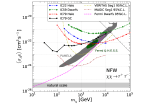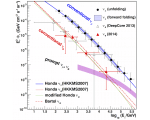In a new study presented a few days ago, the IceCube Collaboration reports the potential of atmospheric muons detected in IceCube to help our understanding of important properties of cosmic rays in a wide range of energies. These muons are also shown to be useful for investigating systematic uncertainties in neutrino studies in IceCube. Measurements of the composition of primary cosmic rays, the high-energy spectrum of muons, and the prompt flux are three of the highlights of this paper, which was submitted last Friday to Astroparticle Physics. […]
Research
An IceCube neutrino alert triggers the discovery of a supernova
On March 30, 2012, IceCube detected two high-energy neutrino events. IceCube immediately sent an alert to several optical and X-ray telescopes—the Robotic Optical Transient Search Experiment (ROTSE), the Palomar Transient Factory (PTF) and the Swift satellite—and a core-collapse supernova was discovered in the PTF images. However, physicists have shown that this was a coincidental discovery and that this supernova is not likely to be the source of the neutrinos in IceCube. These results have been submitted today to the Astrophysical Journal and are the outcome of a joint study between the IceCube Collaboration and members of the PTF Collaboration, the Swift Collaboration and the Pan-STARRS1 Science Consortium. […]
A search for dark matter in the galactic center
In a new analysis of the IceCube Collaboration, a search for dark matter annihilation at the Galactic Center is presented using data from May 2010 to May 2011. The highest density of dark matter in the Milky Way is anticipated to concentrate in its center. Dark-matter self-annihilation should then produce a flux of muon neutrinos and other particles that peaks in the direction of this region, which is seen in the Southern Hemisphere by IceCube. The search did not find a neutrino excess, and the researchers have set new limits on the dark-matter self-annihilation cross section. These results have been submitted today to European Physical Journal C. […]
A new year of data for IceCube
Not everyone begins a new year on January 1, right? That includes IceCubers, who decided a while ago that mid May would be a good time to start a new year of data for the South Pole neutrino observatory.
The IC86-2014 physics run ended on May 18, 2015, wrapping up another successful year for the IceCube detector. […]
A measurement of the atmospheric electron neutrino spectrum with IceCube
In a new analysis by the IceCube Collaboration, the atmospheric electron neutrino spectrum is measured at energies between 0.1 TeV and 100 TeV, extending previous measurements to higher energies and yielding improved precision. The results, which have been submitted to Physical Review D, find good agreement with models of the conventional electron neutrino flux. […]
Latest result from neutrino observatory IceCube opens up new possibilities for particle physics
The South Pole observatory IceCube has recorded evidence that elusive elementary particles called neutrinos changing their identity as they travel through the Earth and its atmosphere. The observation of these neutrino oscillations, first announced in 1998 by the Super Kamiokande experiment in Japan, opens up new possibilities for particle physics with the Antarctic telescope that was originally designed to detect neutrinos from faraway sources in the cosmos. […]
Searches for time-dependent neutrino sources with IceCube
Searches with IceCube have so far persistently shown us that more data is needed to reveal the first cosmic ray source. But IceCube researchers are convinced that success also requires a resolute determination to exploit IceCube data in every possible manner. In a new study submitted today to the Astrophysical Journal, the collaboration presents a search for time-dependent astrophysical neutrino sources that did not find any evidence for their existence. The study did however make it possible to set upper limits on the neutrino flux from several source candidates and has proven IceCube’s capabilities for long-term monitoring of sources triggered by multiwavelength information from several experiments. […]
Measuring the flavor ratio of astrophysical neutrinos
In a new measurement of the flavor ratio of astrophysical neutrinos, submitted today to Physical Review Letters, the IceCube Collaboration has found good agreement with the standard source model. The collaboration also sets limits on nonstandard flavor compositions, which could be a signature for new physics in the neutrino sector, such as neutrino decay or sterile neutrinos. […]
Gamma-ray bursts are not main contributors to the astrophysical neutrino flux in IceCube
Gamma-ray bursts (GRBs) were once the most promising candidate source of ultra-high-energy cosmic rays (UHECRs). They release extremely large amounts of energy in short periods of time, so if they could accelerate protons as they do electrons, then GRBs could account for most of the observed UHECRs. […]
Atmospheric neutrino oscillations measured with three years of IceCube data
Last year, an initial measurement of the neutrino oscillation parameters was a hint that IceCube could become an important detector for studying neutrino oscillations. Today, the IceCube Collaboration has submitted new results to Physical Review Letters that present an improved measurement of the oscillation parameters, via atmospheric muon neutrino disappearance, which is compatible and comparable in precision to those of dedicated oscillation experiments such as MINOS, T2K or Super-Kamiokande. […]









